Ride Don’t Walk After Dark: Bike Lights for Kids
It’s never been our goal to bike at night with kids. However, for the last few bike seasons, my family has found ourselves occasionally finishing a ride in fading twilight.
Usually, this happens in the autumn. The decreasing daylight surprises us every October and inevitably we find ourselves riding later than we expected. If the sun is setting as we finish, we bike a little slower and choose the easier and less wooded route. Thus far, we have avoided mishaps. But it’s risky.
As an Amazon Associate and member of other affiliate programs, we earn from qualifying purchases.
For safety’s sake, we invested in a fleet of bike lights — the Magicshine 900S — to help us finish our rides.
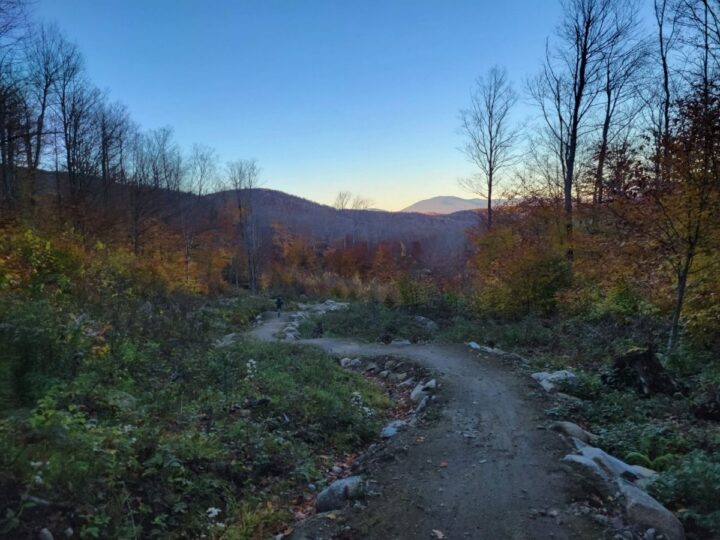
Helmet Lights Versus Bike Lights
If you are preparing for the occasional dusky ride to the parking lot, you can probably get away with either a very bright helmet light or a bike light.
If you or your family plans to bike after dark often, you should have both a helmet light and a bike light. The bike light shines where the bike is pointed — down the trail or road — and is usually the first upgrade for anyone seeking to ride at night.
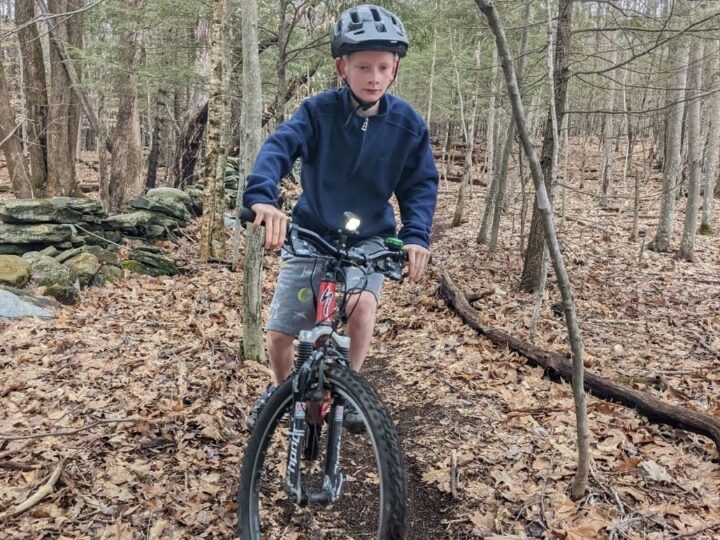
A helmet light illuminates where the rider’s head is looking — making navigation easier. With a helmet and bike light combination, both where you are going and where you are looking will be illuminated.
Helmet lights can also serve as backup lights if any of the main bike lights fail.
Are you hoping to ride roads after dark? Then you will need three lights — a bike light, a helmet light, and a tail light that will make you visible from behind.
Bike Light Advantages
If you want something easy to use and always ready, the bike light is right.
Bike Lights Increase Visibility
Bike lights (both front and rear lights) increase the biker’s visibility to cars and other bikers. Because these lights are attached to the bike, drivers can recognize you as a cyclist.
For additional visibility, use reflective gear — especially on your wheels.
Bike Lights Can be Set Up Once
Once the bike light is installed, it’s ready to go. All you need to do is push a button on the handlebar or on the light, and your path is illuminated.
Helmet Light Advantages
What the helmet light lacks in comfort and ease, it makes up for with versatility.
Helmet Lights Illuminate Where You Look
When navigating, riders typically want to forks in the road or glance at signs that may not be fully illuminated by their bike light’s beams. In these conditions, the helmet light truly shines (pun intended).
Helmet Lights Can Be Used in Other Sports
Additionally, helmet lights may be used in other sports, such as alpine touring. For families that love backcountry skiing and biking these can be versatile and essential equipment.

Helmet-Compatible Bike Lights for Kids
The happy medium between a versatile helmet light and a convenient bike light is the helmet-compatible bike light. These lights are designed to fit on the bike but may be mounted to a helmet.
Some mounts use a Garmin or GoPro Mount while other lights fit into a brand-specific mount. Either way, expect to buy a mount for your helmet.
Your bike light cannot be both on your head and on your bike at once. If your family is riding at night often, you’ll still need two lights — usually a brighter one for the bike and a less intense light on the helmet.
How Bright Should Your Light Be?
When selecting a light, it’s important to consider where you are planning to bike. While there is no consensus on the number of lumens needed, most sources agree that you need more lumens for trail riding than to be visible in an urban environment.
If the roads are well-lit, you and your kids don’t need more than 200 lumens to be seen. A range of 100-200 lumens will alert drivers to your presence without blinding the drivers — or you when your kids accidentally shine their light in your eyes!
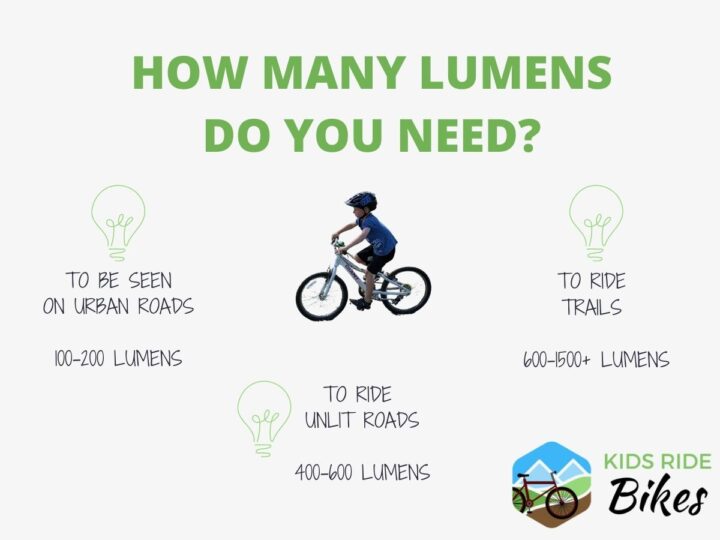
When the roads are poorly lit, riders need brighter lights. Most sources recommend 400-600 lumens for rural roads.
Trails require a light between 600 to 1500 lumens. Keep in mind that most lights offer multiple settings. The highest light setting uses the most battery power while a lower setting will help the battery last longer.
If you plan to use the lights on trails, look for lights that have sufficient battery power and multiple settings to save power — especially if you are planning a longer ride.
Usually, lights bright enough for trails have lower settings that can illuminate roads well or be used as a daytime running light.
Features to Consider for Bike Lights for Kids
Kids can be tough on equipment. When considering purchasing high-quality lights for kids, look for a lightweight, durable light that can withstand abuse.
Weight
While weight matters less when the light is affixed to the bike’s handlebars, it becomes important if the light is on your kid’s helmet. Your kid will be most comfortable with a lighter helmet attachment.
Remote Operated
Some lights have a remote that allows a rider to use the light seamlessly while riding. With a remote button, your kids can simply push a button on near their handgrips to operate the light.
Durability and Water Resistance
These should always be considered when talking about equipment for kids. Kids (or at least my kids) leave things outside in the rain. They drop their bikes on the ground after every ride (despite frequent reminders!). They smack into branches or tip over more than adults.
It’s always worth a few extra dollars to get a more durable or water-resistant light.
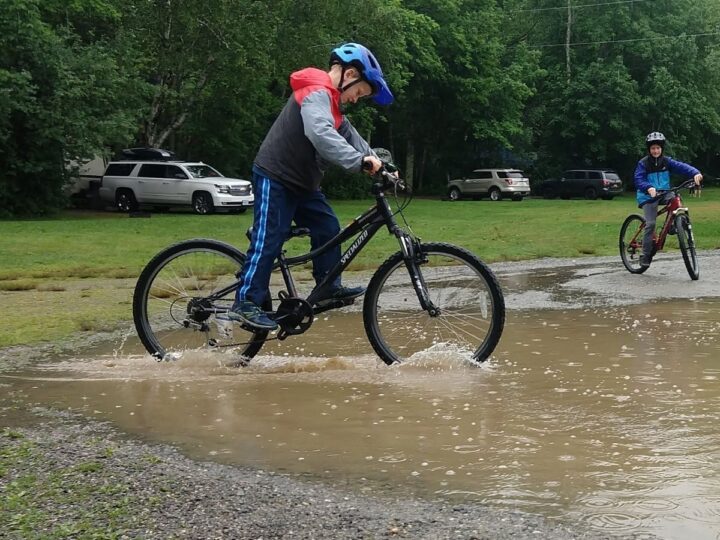
IPX is a measure of an object’s water resistance. If the light is rated at IPX0, it should never get wet. Most bike lights are rated IPX4 or IPX6. A rating of IPX4 means the device can withstand water splashes from all directions. IPX6 electronics can function after high-pressure sprays of water from all directions.
With kids, a higher IPX means that their light might survive a little longer!
Battery Run Time
The battery run time can vary greatly between high power and low power or flashing. Look for a light with a longer battery run time and multiple power settings.
Another bonus: If your kid leaves the light on overnight, a longer run time may mean that it won’t need to be charged the next day.
Mounting System
Many lights use a universal mounting system, such as that employed by Garmin or GoPro products. Multi-use mountings allow your kids to record their stunts during daylight and then use the lights after dark.
Other lights use a bracket or hook-and-loop system to attach to the bike. To convert to a helmet light, these brands offer their own unique mounting system.
Recommended Lights For Trail Riding With Kids
When our family was shopping for bike lights, we wanted a helmet-compatible light with over 1,000 lumens at a reasonable price.
Eventually, we settled on the Magicshine MJ900S. Here is how it racks up compared to similar helmet-compatible lights. This is by no means a comprehensive list but a comparison of a few well-reviewed lights.
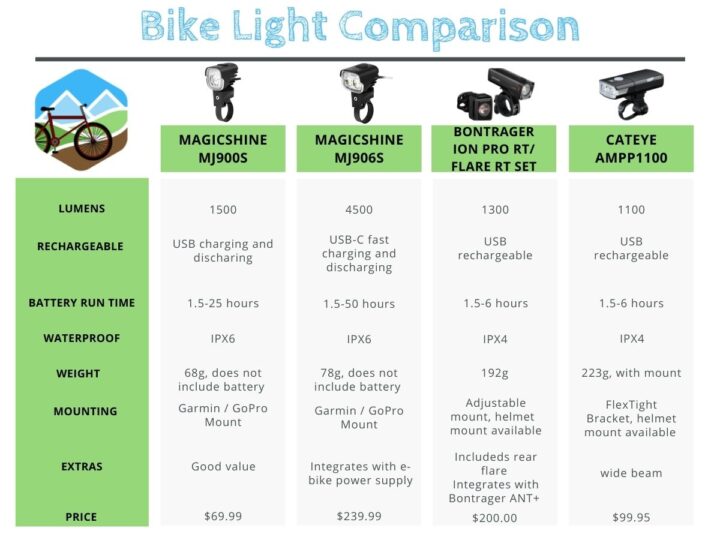
Best for Kids: Magicshine MJ 900S
If you have kids, you know that they are rough on just about everything. The Magicshine MJ 900S provides enough light and some durability to withstand normal adult usage.
But the biggest advantage is its price. Yes, it’s an expensive light — especially if you are outfitting a family. But compared to most bike lights with a similar amount of lumens, it is very reasonable. At this price, you’ll be annoyed if it breaks but not outraged.
Brilliantly Bright
The MJ900S bike light emits a respectably bright light — up to 1500 lumens, but its big brother the Magicshine MJ906S can give off 4,500 lumens!
Mounts to Garmin/GoPro Adapter
Both Magicshine lights use GoPro mounts, which are simple to use and can pair with other devices. Fewer handlebar attachments is a win in my book!
If you hope to use the light on a helmet, Amazon carriers a six-pack of helmet mounts for under $10. This particular pack includes 6 curved mounts for helmets and 6 flat mounts for anywhere.
Versatile Battery Pack
The battery pack finally convinced our family that these were the right lights for us. Because the battery pack can both charge and discharge, it doubles as a portable cell phone charger!
We plan to bring one or two of these battery packs with us on hikes or while camping as a battery backup.
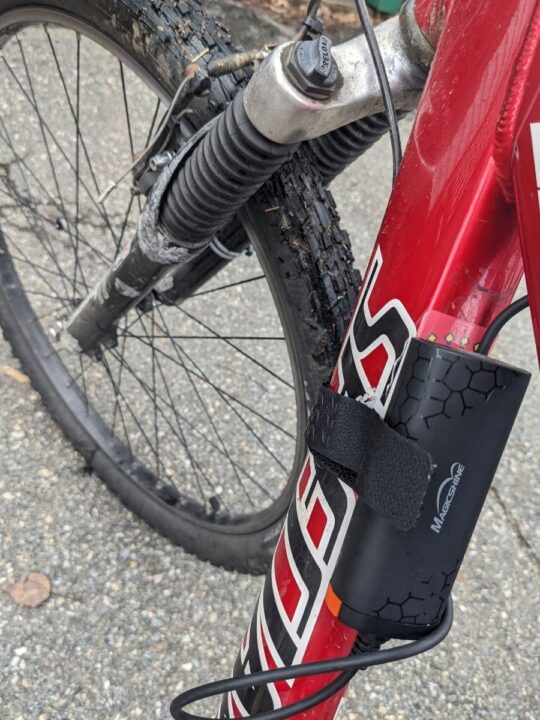
The drawback to having a separate battery pack is that the pack must be wrapped onto the bike handlebars if you are using it as a bike light.
If you put the light on a helmet, then you have to figure out where to attach the battery pack. It can either be attached to the back of the helmet or stored in a backpack. Either way, you’ll have annoying wires draped over your helmet.
What We Would Change About the Magicshine Bike Light
Our family has loved using the Magicshine MJ900S, but we have noticed a few issues. First, the battery pack can feel very heavy if it is worn on the helmet. We recommend putting it in your child’s backpack if possible.
This basic model doesn’t have a remote control option. Even if it is installed as a bike light, most kids will have to stop riding to turn it on. While a minor inconvenience, some kids won’t take the 30 seconds needed to pause their ride and turn on the light.
Other Helmet Compatible Light Options
Best for E-Bikes: Magicshine 906S
If your family has decided to invest in e-bikes, the MJ906S is a good choice. Considered “e-bike ready,” it integrates with the e-bikes power supply. This extremely bright light is also very water-resistant.
Best for Road Rides: Bontrager Ion Pro RT/Flare RT Light
This combination of rear and front lights were designed for road bikers in both urban and rural environments, but it has enough lumens for trail riding as well. Designed with a wide beam, this little light can flood a road or trail with light.
The Bontrager Ion Pro integrates with other Bontrager devices or Garmin devices. If your family enjoys using Bontrager ANT+’s platform, then this light will fit in well.
Unlike the Magicshine options, the Bontrager cannot withstand heavy sprays and may not be ideal in a rainy climate.
Best for Peripheral Vision on Trails: CATEYE AMPP1100
With its unique side lens, the CATEYE AMPP1100 offers a wide angle of light. Riders can see obstacles or changes in the trail more easily.
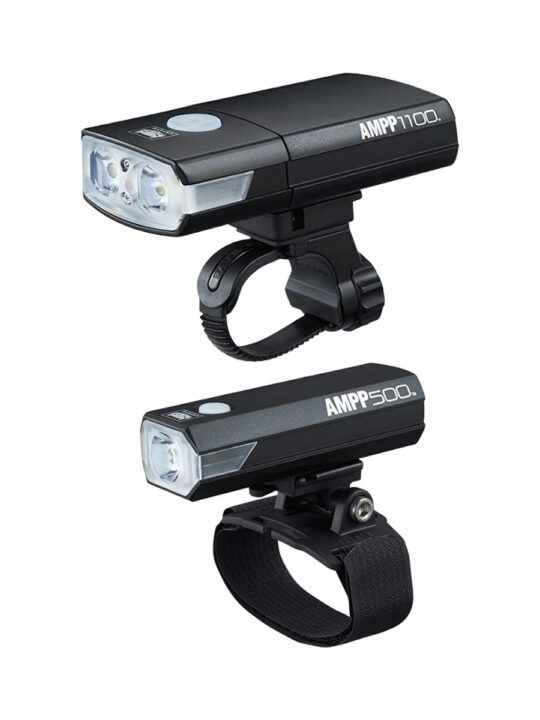
Amazon offers the CATEYE AMPP110 bike light in a bundle with the CATEYE AMPP500 helmet light for $129. This combination is a solid choice for older kids who want to ride trails at night often because it combines both a helmet light and bike light at a reasonable price.
With an IPX4 rating, the CATEYE will not endure heavy rains or direct spray.
Fear No Twilight Ride
With a new collection of bike lights, our family has been able to embrace late afternoon rides. After school, or even after dinner, we can ride, confident of a safe, well-lit return.
Related Articles:
- Best Bike Helmets For Kids in 2022
- Best Mountain Bike Gear for Women
- Aero Tech Designs Cycling Kits for Kids Review
Best Bike Lights for Kids
© 2022, Kids Ride Bikes. All rights reserved. Republication, in part or entirety, requires a link back to this original post and permission from the author.

